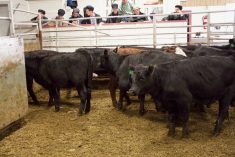Pasture and forage Crown land leaseholders say they sense progress after the province announced rental relief for the next three years.
Leaseholders can expect rents to be halved for 2023, the province said Sept. 28. Rates will gradually ramp up over the final two years, to 77 per cent of current levels in 2024 and 85 per cent the following year.
The province estimates the announcement will bring up to $4 million in rental relief.
Read Also

Seeding Indigenous agricultural prosperity
National Circle for Indigenous Agriculture and Food says Indigenous agricultural success needs strong relationships.
“We are appreciative of the temporary rent reduction from the Manitoba government, and look forward to sending in comments on potential changes to the Crown lands system,” said Brent Benson, president of the Manitoba Crown Land Leaseholders Association, noting the association’s lobby efforts have now stretched over three years.
Why it matters: Forage leaseholders have been pushing for changes to the Crown land system since new regulations were unveiled in 2019.
Manitoba Agriculture Minister Derek Johnson linked the move to weather challenges.
Agricultural Crown lands have taken a serious hit to their productive capacity over the last two years, the province noted.
Regions including the Interlake were hard hit in last year’s drought, leading to a widespread exodus of cattle as producers struggled to feed their herds. This spring, the pendulum swung to the opposite extreme. Late snowstorms and flooding led to calf deaths and other lost stock.
Those challenges coincided with spikes in rent, following changes to the Crown land lease regulations unveiled in 2019. Under the changed system, rents went from $2.13 per animal unit month to a market-based formula that was expected to increase rents by up to 350 per cent over two years.
Producers paid half of that increase in 2020, with the full brunt expected in 2021 — a year when drought came to a head. The timing of implementation also presented producers with two bills in the same calendar year as the system changed over.
The province defended the new system, saying the market-based formula was more transparent and that rental rates had been frozen for years. It said increases were necessary to help recover costs.
Some leaseholders were later promised relief in 2020. That year, the province announced a more limited list of Crown land rent reductions. Those breaks, coming off another dry year in 2019, offered a 20 per cent reduction in the following year’s bill in any municipality that had announced a state of agricultural disaster in 2019 due to lack of forage.
Recovery
The current rent reduction will be in place, “as the productivity of the land recovers and as further improvements to the Agricultural Crown Lands program are implemented,” said a Sept. 28 statement from the province.
“The Agricultural Crown Lands program supports a vibrant and sustainable agricultural sector, and our government is committed to ensuring it continues to meet the needs of Manitoba’s livestock industry,” Johnson said.
Reductions will be automatically applied to leaseholders’ bills and will not require them to apply.
Tyler Fulton, president of Manitoba Beef Producers, welcomed the new rental timeline. The group had asked the province to re-evaluate how quickly rates were increasing, arguing that a more gradual rise would be less disruptive.
“There’s been just a ton of back and forth and work with providing that producer perspective to the government,” said Fulton.
“I’m heartened by the fact that they’re heeding that advice and I really think that it’s a positive thing that they acknowledged the hardship that we’ve seen in our sector.
“That said, we’ve also asked for a number of other changes to the Crown lands file that we think would be really positive for maintaining the herd and really improving the sustainability of the beef industry, in particular with respect to Crown land.”
Further changes
The province hinted at future changes that would encourage investment in land improvements, as well as general “adjustments to the terms and conditions of leases.”
Earlier this year, the province announced a one-year productivity pilot that promised funds to 42 cost-shared projects targeted to increase productivity.
While rent has been a long-time sticking point for leaseholders, other long-standing complaints argue for better arbitration when valuing land improvements, as well as the outstanding issue of unit transfers.
Producers had initially been told that existing leaseholders would get one last chance to package lease rights with their private land value when they sold, something that some leaseholders said was critical to retirement plans because most of their land base was leased land.
That clause was later removed from the regulations, sparking outrage among producers.
The province has launched an online EngageMB survey to gather feedback on the Agricultural Crown Lands program. The survey will run until late October and can be found at engagemb.ca/agcl-forage-leases.
Benson urged producers to take the province up on that chance.
“It appears that Minister Johnson is actually listening to producers, and we are hopeful that the consultation process will result in more positive changes to come,” he said.
















